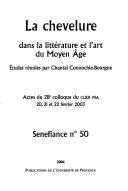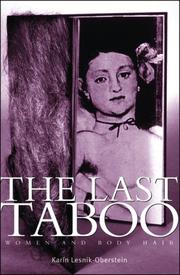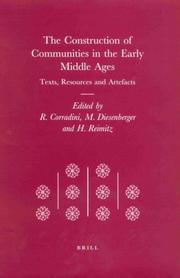| Listing 1 - 5 of 5 |
Sort by
|

ISSN: 03391752 ISBN: 2853995674 2821836996 9782853995672 Volume: 50 Publisher: Aix-en-Provence
Abstract | Keywords | Export | Availability | Bookmark
 Loading...
Loading...Choose an application
- Reference Manager
- EndNote
- RefWorks (Direct export to RefWorks)
Ce volume rassemble les 27 contributions des Actes du colloque du CUER MA (2003) dans divers domaines de la civilisation du Moyen Âge : littérature, peinture, médecine, hygiène, cosmétique, mode, religion... Il n'est de chevelure qu'humaine. Située au chef du corps, elle est métonymique de celui ou celle qui l'offre naïvement auxregard ou bien en joue ou encore la couvre ou s'en prive. Sa couleur, la façon dont est arrangée ou dérangée, ornée ou tondue, sont des signes qu'on perçoit d'emblée ou qu'il faut interpréter. Elle dénote une nature, un âge, une appartenance au monde de la lumière ou des ténèbres. Fixée en boucles menues, retenue par une tresse, galonnée d'or, sagement (ou follement!) couverte, teinte ou postiche, déployée, déferlant parfois jusqu'aux pieds pour couvrir la nudité, sauvagement ébouriffée, arrachée en signe de deuil, rasée, blessée d'une tonsure, elle signale le rapport que l'individu entretient avec les normes de la société à laquelle il appartient. Parfois, il suffit d'un cheveu (d'or!) pour dire l'amour d'une Dame ou, métaphoriquement, les subtilité d'un art d'écrire (4e de couv.)
Old French literature --- Thematology --- Hair --- Hair in literature --- French literature --- Literature, Medieval --- Cheveux --- Cheveux dans la littérature --- Littérature française --- Littérature médiévale --- Congresses --- History and criticism --- Congrès --- Histoire et critique --- Art, Medieval --- Hair in art --- Medieval literature --- History and criticism. --- Languages & Literatures --- Literature - General --- Congresses. --- Medieval literature - History and criticism. --- French literature - To 1500 - History and criticism. --- littérature médiévale --- stéréotype littéraire --- féminité (littérature) --- chevelure (littérature) --- LITTERATURE MEDIEVALE --- ART MEDIEVAL --- CHEVEUX --- HISTOIRE ET CRITIQUE --- THEMES, MOTIFS --- HISTOIRE --- MOYEN AGE --- DANS LA LITTERATURE --- ASPECT SYMBOLIQUE --- DANS L'ART
Book
ISBN: 9782853997348 2853997340 2821835973 Year: 2010 Volume: 57 Publisher: Aix-en-Provence: Publications de l'Université de Provence,
Abstract | Keywords | Export | Availability | Bookmark
 Loading...
Loading...Choose an application
- Reference Manager
- EndNote
- RefWorks (Direct export to RefWorks)
Old French literature --- Thematology --- History of civilization --- French literature --- Women in literature. --- Hair in literature. --- Feminine beauty (Aesthetics) in literature --- Littérature française --- Femmes dans la littérature --- Cheveux dans la littérature --- Beauté féminine (Esthétique) dans la littérature --- History and criticism. --- Histoire et critique --- Women in literature --- Hair in literature --- History and criticism --- Littérature française --- Femmes dans la littérature --- Cheveux dans la littérature --- Beauté féminine (Esthétique) dans la littérature --- French literature - To 1500 - History and criticism --- littérature médiévale --- stéréotype littéraire --- féminité (littérature) --- chevelure (littérature)

ISBN: 178170256X 1847794440 9781847794444 9781781702567 9780719075001 0719075009 Year: 2006 Publisher: Manchester : Manchester University Press,
Abstract | Keywords | Export | Availability | Bookmark
 Loading...
Loading...Choose an application
- Reference Manager
- EndNote
- RefWorks (Direct export to RefWorks)
This is the first academic book ever written on women and body hair, which has been seen until now as too trivial, ridiculous or revolting to write about. Even feminist writers or researchers on the body have found remarkably little to say about body hair, usually ignoring it completely. It would appear that the only texts to elaborate on body hair are guides on how to remove it, medical texts on 'hirsutism', or fetishistic pornography on 'hairy' women. The last taboo also questions how and why any particular issue can become defined as 'self-evidently' too silly or too mad to write about.
Body image in women. --- Hair --- Hairs --- Body covering (Anatomy) --- Head --- Scalp --- Women --- Social aspects. --- Psychology --- Body Image. --- Hair. --- Taboo. --- Women. --- Image du corps chez la femme --- Cheveux --- Aspect social --- Western culture. --- beautification. --- body hair. --- femininity. --- fetishistic pornography. --- hair removal. --- hairy women. --- hirsutism. --- natural female body. --- women.
Book
ISBN: 3319734970 3319734962 9783319734965 Year: 2018 Publisher: Cham : Springer International Publishing : Imprint: Palgrave Macmillan,
Abstract | Keywords | Export | Availability | Bookmark
 Loading...
Loading...Choose an application
- Reference Manager
- EndNote
- RefWorks (Direct export to RefWorks)
This volume brings together a range of scholars from diverse disciplinary backgrounds to re-examine the histories of facial hair and its place in discussions of gender, the military, travel and art, amongst others. Chapters in the first section of the collection explore the intricate history of beard wearing and shaving, including facial hair fashions in long historical perspective, and the depiction of beards in portraiture. Section Two explores the shifting meanings of the moustache, both as a manly symbol in the nineteenth century, and also as the focus of the material culture of personal grooming. The final section of the collection charts the often-complex relationship between men, women and facial hair. It explores how women used facial hair to appropriate masculine identity, and how women’s own hair was read as a sign of excessive and illicit sexuality.
History. --- History, Modern. --- World history. --- Civilization --- Social history. --- Sociology. --- Sex (Psychology). --- Gender expression. --- Gender identity. --- Cultural History. --- Social History. --- World History, Global and Transnational History. --- Gender Studies. --- Modern History. --- Sex identity (Gender identity) --- Sexual identity (Gender identity) --- Identity (Psychology) --- Sex (Psychology) --- Queer theory --- Expression, Gender --- Sex role --- Psychology, Sexual --- Sex --- Sexual behavior, Psychology of --- Sexual psychology --- Sensuality --- Social theory --- Social sciences --- Descriptive sociology --- Social conditions --- Social history --- History --- Sociology --- Cultural history --- Universal history --- Modern history --- World history, Modern --- World history --- Annals --- Auxiliary sciences of history --- Psychological aspects --- Beards --- Beard --- Face --- Hair --- Apparence individuelle. --- Beards. --- Coiffures (cheveux). --- Hair. --- Histoire. --- Moustache. --- Mustaches --- Mustaches. --- Social aspects. --- Civilization-History. --- Civilization—History.

ISSN: 13864165 ISBN: 1280914599 9786610914593 9047404068 1429407042 9004118624 9789004118621 9781429407045 9781280914591 6610914591 9789047404064 Year: 2003 Volume: 12 Publisher: Leiden ; Boston : Brill,
Abstract | Keywords | Export | Availability | Bookmark
 Loading...
Loading...Choose an application
- Reference Manager
- EndNote
- RefWorks (Direct export to RefWorks)
This volume provides a complex discussion of the variety of social efforts which were undertaken to create meaningful communities in the process of the formation of the early medieval gentes and kingdoms in the post-Roman west.
Social history --- Civilization, Medieval. --- Communities --- History --- Europe --- Communities. --- Ethnogenese. --- Groupes sociaux --- HISTORY. --- Histoire sociale --- Lokale gemeenschappen. --- Vroege middeleeuwen. --- Völkerwanderungszeit. --- Histoire --- Medieval. --- To 1500. --- Europe. --- Civilization, Medieval --- Community --- -Social history --- -940.1 --- Medieval civilization --- Middle Ages --- Descriptive sociology --- Social conditions --- -History Europe Middle Ages (476 - 1453) --- Civilization --- Council of Europe countries --- -History --- Ethnicity --- Ethnicité --- Holy Roman Empire --- Saint Empire romain germanique --- Politics and government --- Religious life and customs --- Conditions sociales --- Politique et gouvernement --- Vie religieuse --- Social groups --- Chivalry --- Renaissance --- 940.1 --- History Europe Middle Ages (476 - 1453) --- Social history - Medieval, 500-1500 --- Communities - History - To 1500 --- Europe - History - To 476 --- Europe - History - 476-1492 --- EMIGRATION ET IMMIGRATION --- BURGONDES --- AVARS (PEUPLE DU CAUCASE) --- CHEVEUX --- GREGOIRE DE TOURS (SAINT), EVEQUE DE TOURS, 538?-594? --- HISTORIOGRAPHIE --- ALARIC I, ROI DES WISIGOTHS, 370?-410 --- HISTOIRE --- 4E-10E SIECLES --- MOYEN AGE --- CRITIQUE ET INTERPRETATION --- AL-ANDALUS --- Émigration et immigration
| Listing 1 - 5 of 5 |
Sort by
|

 Search
Search Feedback
Feedback About UniCat
About UniCat  Help
Help News
News